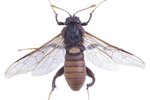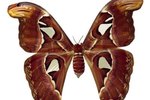New York State has a large ecosystem of animal, insect and plant life that thrive in the the area. Forest covers 62 percent, or 18.6 million acres of land, in New York, states the Department of Environmental Conservation. The vast expanse of forests has made it an ideal habitat for a variety of different caterpillars.
Cecropia Caterpillar
Cecropia caterpillars grow into one of the largest moths in the state of New York. The larvae consume a variety of shrubs and trees, including ash, beech, birch, cherry, dogwood and maple. When fully grown, cecropia caterpillars get as long as 1.5 inches. They are green in color and have small yellow bristles, which grow off their backs. Cecropia caterpillars create a cocoon for the winter on small twigs just off the ground and emerge during the warmer spring months.
Gypsy Moth Caterpillar
Introduced into the United States in 1869, the gypsy moth caterpillar originated in Europe. This species of caterpillar was originally brought to the U.S. as a breeding partner for silk worms. Now, the gypsy moth caterpillar is a permanent resident in the State of New York and has developed a reputation for defoliation of native trees, such as alder, birch, poplar and willow trees. The larvae start out with brown or black coloring and later develop small bumps along their back with coarse black hairs. Mature caterpillars grow to 2.5 inches and form a cocoon through winter, emerging in August.
Tent Caterpillar
Tent caterpillars are native to the State of New York, but have the same devastating effects on trees as gypsy moth caterpillars. Feeding during the night to avoid predators, tent caterpillars weave communal nests in the tree branches of cherry and apple trees. They will defoliate an entire tree in a few weeks. A full-grown tent caterpillar is around 2.5 inches in length and is black with a white stripe down the back and yellow or blue spots down the side. It takes three weeks for a tent caterpillar to exit its cocoon.
Hickory Horned Devil Caterpillar
The hickory horned devil caterpillar is found in New York, Michigan, Texas and even Florida. This species of caterpillar later evolves into the royal walnut moth. Feeding on pecan, butternut and hickory trees, the hickory horned devil caterpillar is quite large -- a fully-grown one will reach six inches in length. They are distinguished by their green coloring, five pairs of large hornlike spikes on their back and smaller spikes covering the rest of their body. The spike tips are sometimes orange and black in color. This species of caterpillar spends the winter pupating. In the spring, they emerge as a moth.
References
Photo Credits
-
Jupiterimages/Photos.com/Getty Images
Writer Bio
Alexander Sam is an avid photographer/traveler. After completing a trip across India, Thailand and Laos he decided that he wasn't made for the cubicle job. Presently he is backpacking across South America and hopes to find himself in another part of the world at this time next year. Sam studied sociology at York University.





